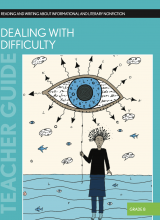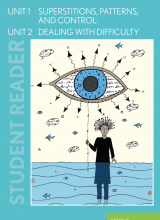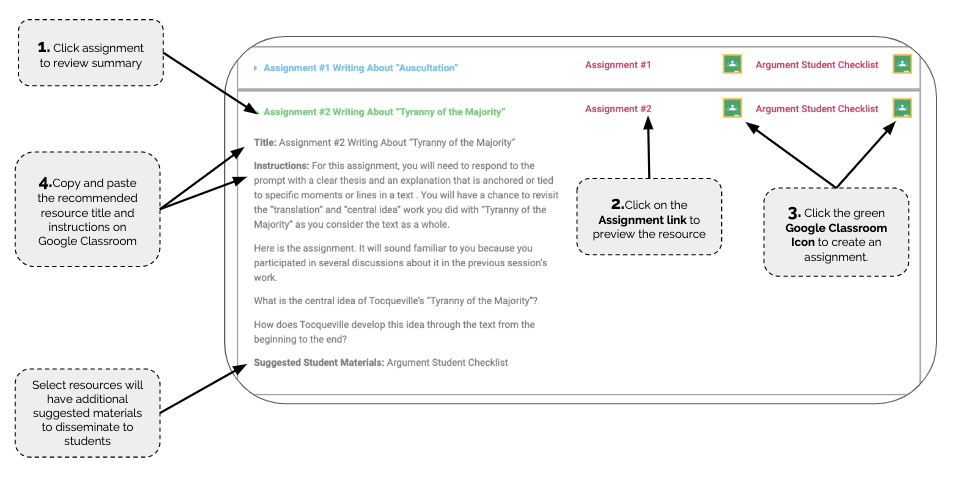Dealing With Difficulty - Grade 8
The Dealing With Difficulty series was conceived as part of Inquiry By Design’s efforts to ensure that secondary students have regular and supported opportunities to work with difficult texts. Each module at each grade level is an excursion into difficulty that is important in and of itself, but that is also valuable because it supplies a basis for reflection and comparison in subsequent experiences with difficult texts.


Table of Contents
Writing Tasks
Title: Small-Group Work: Making Sense “Foolology”
Teacher Manual Instructions:
Session 1-B
Ask students to select one of the difficult moments they identified during Session 1-A that they want to work on.
Place each student with a partner and explain that each pair will work on two lines in the following way:
Work together to say what you think the moment or line means.
Describe how you made sense of it.
Capture your work for each moment or line on the “Making Sense” chart in your notebook.
Explain to students that they should take 5-7 minutes to work on each of their lines.
Use this time to confer with students about their selections and their chart entries.
Title: Small-Group Work: What message do you think Reed is sending in “Foolology”?
Teacher Manual Instructions:
Session 1-C
After students have finished their quick writes, place them in groups of twos or threes.
Distribute chart paper and markers to the groups and ask students to work with their partners to create a chart (or charts if members of the group disagree about the message Reed is sending). Tell the class that each chart should include the following information:
A brief answer to the question, “What message do you think Reed is sending in ‘Foolology’?”
Summaries or excerpts of the lines or moments from the text that provide evidence to support that position.
Remind students to draw on their quick writes, their notes, and the wall charts to do this work.
Give students 7-10 minutes to create their charts.
Use this time to confer with groups about the task.
Title: Searching and Studying “The Lives of a Cell” Comprehension Task
Teacher Manual Instructions:
Session 2-B
Place students in groups of twos or threes.
Negotiate expectations and rules regarding issues such as library visits, computer use, and science textbook gathering that students might require during their work on this assignment.
Give students time to meet in their small groups to complete the retelling work for the remaining three sections of Thomas’ essay. Groups will likely need time beyond this class meeting to complete this task.
Use this time to confer with groups about this work.
Title: Small-Group Work: What are the implications of the idea that the earth is most like a cell?
Teacher Manual Instructions:
Session 2-C
Distribute the writing task and ask students to work with their partners. Tell the class that each group should include the following information:
A brief answer to the question, “What are the implications of the idea that the earth is most like a cell?”
Summaries or excerpts of the lines or moments from the text that provide evidence to support that position.
Remind students to draw on their quick writes, their notes, and the wall charts to do this work.
Give students 7-10 minutes to create their charts.
Use this time to confer with groups about the task.
Title: Argument Interpretive Assignment #1 Writing About “Foolology”
Teacher Manual Instructions:
For this assignment you will write an argument about “Foolology” that answers the question in the box below. It will sound familiar to you because you participated in a discussion about it in the previous session’s work.
What is Reed’s message in “Foolology”?
Suggested Student Materials: Interpretive/Argument Student Checklist
Title: Argument Interpretive Assignment #2 Writing About “The Lives of a Cell”
Teacher Manual Instructions:
For this assignment you will write an argument about “The Lives of a Cell” that answers the question in the box below. It will sound familiar to you because you participated in a discussion about it in the previous session’s work.
What is the most important message in Thomas’ “The Lives of a Cell”?
Suggested Student Materials: Interpretive/Argument Student Checklist
Charts for Discussion
Title: Difficulty in “Foolology” What and Why?
Teacher Manual Instructions:
Session 1-A
Ask students to work independently for a moment to review their difficulty markings in “Foolology” and to identify three moments or lines
they marked. Give students 4-5 minutes to make an entry for each line or moment on the chart they created in their notebook. Remind students to be sure to copy down the difficult line number or the moment as it is written in the poem in the “What’s difficult?” column.Next, place students in groups of twos or threes and ask them to share their chart entries with their partner(s). Give each group a piece of chart paper and a marker and ask students to work together to create a master “What’s difficult?/Why is it difficult?” chart for their group. Explain that at the end of the small-group work, each group will post its chart on the wall so the rest of the class can review it and all of the other charts prior to the upcoming whole-group discussion. Give groups 7-10 minutes to build their charts.
Closing Meeting
- Give students 3-5 minutes to walk around and read the other charts.
- Convene a whole-class discussion about the work. You might initiate the conversation by saying something like this:
“Let’s take a look at what you guys think is difficult in the poem and what it is about those moments or lines that you think make it difficult.”
- During this conversation, be sure to capture the class’ thinking on a new chart titled “Difficulty in ‘Foolology’: What and Why?” that can be displayed for the whole class to see. (You will need to display this chart in the next session.) This conversation is a chance for the class to notice overlaps across groups and to benefit from the thinking each group did. Students should add information to the “What and Why?” charts in their notebooks as well during this discussion.
Title: Making Sense of “Foolology”
Teacher Manual Instructions:
Session 1-B
Ask students to create a version of the same chart in their notebooks.
Give students time to finish their charts and then select one of the moments listed on the class’ “What and Why?” chart and copy it into the first column of the “Making Sense” chart.
Next, pose the work of the second column as a question to the class:
“What do you think this line means?”
Invite one or two volunteers to offer some ideas and then encourage other students to extend, push back, or otherwise respond to their ideas.
Spend 4-5 minutes discussing this line and, afterwards, work with the class to craft entries for the second and third columns of the “Making Sense” chart. (Students should add these model entries to their notebook charts as well.)
- What you think it means. Even if there are a few different compelling ideas about this moment, keep things simple by choosing and entering information for just one.
What did you and your partner do to make sense of the line or moment? Ask the class to step back and think with you for a minute about what “moves” were made to arrive at the “what you think it means” conclusion. For example, did you reread the line? Did you go to another moment in the poem to clarify your thinking about the line? Did you begin with one idea and then test it out and either confirm or change it based on what you found?
Answer any questions students have about the focus lesson experience.
Title: Difficulty in “The Lives of a Cell” What and Why?
Teacher Manual Instructions:
Session 2-A
Ask students to work independently for a moment to review their difficulty markings in “The Lives of a Cell” and to identify three moments or lines they marked. Give students 4-5 minutes to make an entry for each line or moment on the chart they created in their notebook. Remind students to be sure to copy down the difficult line number or the moment as it is written in the essay in the “What is difficult?” column.
Next, place students in groups of twos or threes and ask them to share their chart entries with their partner(s). Give each group a piece of chart paper and a marker and ask students to work together to create a master “What’s difficult?/Why is it difficult?” chart for their group. Explain that at the end of the small-group work, each group will post its chart on the wall so the rest of the class can review it and all of the other charts prior to the upcoming whole-group discussion. Give groups 7-10 minutes to build their charts.
Closing Meeting
Give students 3-5 minutes to walk around and read the other charts in the room.
Convene a whole-class discussion about the work. You might initiate the conversation by saying something like this:
“Let’s take a look at what you guys think is difficult in the essay and what it is about those moments or lines that you think make it difficult.”
During this conversation, be sure to capture the class’ thinking on a new chart titled “Difficulty in ‘The Lives of a Cell’: What and Why?” that can be displayed for the whole class to see. This conversation is a chance for the class to notice overlaps across groups and to benefit from the thinking each group did. Students should add information to the “What and Why” charts in their notebooks as well during this discussion.
Checks for Understanding
Title: Small-Group Work: What did you learn?
Teacher Manual Instructions:
Session 1-D
Conclude the work in this study in the following way:
Place students in groups of twos or threes and ask them to chart a response to the following questions:
What did you learn about this essay from the work in the last few sessions?
What did you learn about dealing with difficult texts from this study of “Foolology”?
Give students 3-5 minutes to read the other charts in the room.
Convene a whole-class discussion about the two questions. Once again, be sure to use the student charts as scaffolds or points of focus for the discussion.
Remind students that as they work with more difficult texts, they will begin to grow a base of experience that will increase their tolerance of difficulty and that will build stamina and instill confidence in their abilities to deal with texts that are hard.
Title: Small-Group Work: What did you learn about dealing with difficult texts from this study of “The Lives of a Cell”?
Teacher Manual Instructions:
Session 2-D
Conclude the work in this study in the following way:
Place students in groups of twos or threes and ask them to chart a response to the following questions:
What did you learn about this essay from the work in the last few sessions?
What did you learn about dealing with difficult texts from this study of “The Lives of a Cell”?
Give students 3-5 minutes to read the other charts in the room.
Convene a whole-class discussion about the two questions. Once again, be sure to use the student charts as scaffolds or points of focus for the discussion.
Remind students that as they work with more difficult texts, they will begin to grow a base of experience that will increase their tolerance of difficulty and that will build stamina and instill confidence in their abilities to deal with texts that are hard.
Independent Reading
Title: Reading Log
Teacher Manual Instructions:
Independent Reading
As you transition to independent reading, discuss how students can keep a reading log. Show students how you would like them to set up and use their reading log to record their independent reading this year. An example of one way a reading log could be set up is provided nearby. You may choose to have students create a table in their notebooks, use a pre-made sheet, or a digital format.
Explain to students that they should make an entry in their log only after they have finished a book. You will need to negotiate with students how to handle the entry of magazine readings (for example, entire issues versus individual articles).
After students have set up the log, including proper headings, creating the grid, etc., show students how to make an entry.
Answer any questions students have about the reading log.
Begin independent reading.
Consider conducting individual reading conferences with students as they are engaged in independent reading. In No More Independent Reading Without Support, Debbie Miller and Barbara Moss (2013) suggest that during early conferences, you should listen to students and work to build trust: Ask students how they view reading and how they think of themselves as readers; ask what they are interested in. Over time you can ask more about what they are reading and about how you can help them or what they are struggling with. Use what you learn from these conversations to guide additional instruction with groups or with the class.
Title: Independent Reading – Individual Planning Sheet
Instructions:
Title: End of Marking Period Self-Assessment
Instructions:
Unit Resources
Title: Searching and Studying “The Lives of a Cell” Comprehension Task
Title: Argument Writing About “The Lives of a Cell”
